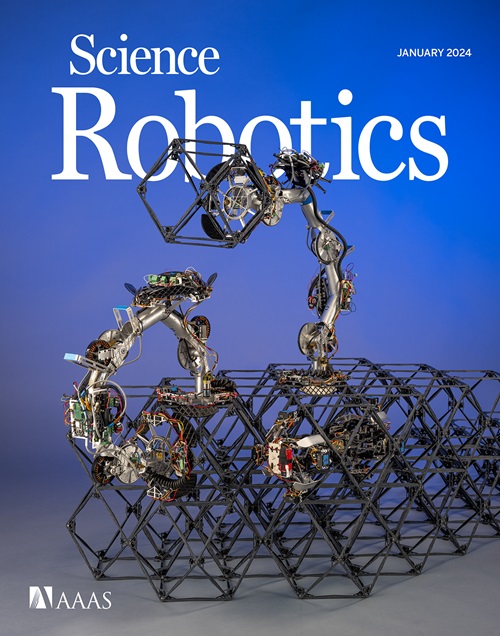Intrinsic sense of touch for intuitive physical human-robot interaction
IF 27.5
1区 计算机科学
Q1 ROBOTICS
引用次数: 0
Abstract
The sense of touch is a property that allows humans to interact delicately with their physical environment. This article reports on a technological advancement in intuitive human-robot interaction that enables an intrinsic robotic sense of touch without the use of artificial skin or tactile instrumentation. On the basis of high-resolution joint-force-torque sensing in a redundant arrangement, we were able to let the robot sensitively feel the surrounding environment and accurately localize touch trajectories in space and time that were applied on its surface by a human. Through an intertwined combination of manifold learning techniques and artificial neural networks, the robot identified and interpreted those touch trajectories as machine-readable letters, symbols, or numbers. This opens up unexplored opportunities in terms of intuitive and flexible interaction between human and robot. Furthermore, we showed that our concept of so-called virtual buttons can be used to straightforwardly implement a tactile communication link, including switches and slider bars, which are complementary to speech, hardware buttons, and control panels. These interaction elements could be freely placed, moved, and configured in arbitrary locations on the robot structure. The intrinsic sense of touch we proposed in this work can serve as the basis for an advanced category of physical human-robot interaction that has not been possible yet, enabling a shift from conventional modalities toward adaptability, flexibility, and intuitive handling.
直观物理人机交互的内在触觉。
触觉是人类与物理环境进行微妙互动的一种特性。本文报告了在直观人机交互方面的一项技术进步,该技术无需使用人造皮肤或触觉仪器即可实现机器人的内在触觉。在冗余布置的高分辨率关节力矩传感基础上,我们能够让机器人灵敏地感受周围环境,并在空间和时间上准确定位人类施加在其表面的触摸轨迹。通过多方面学习技术和人工神经网络的交织组合,机器人将这些触摸轨迹识别并解释为机器可读的字母、符号或数字。这为人类与机器人之间直观、灵活的互动开辟了尚未开发的机会。此外,我们还展示了所谓虚拟按钮的概念,可用于直接实现触觉通信连接,包括开关和滑动条,与语音、硬件按钮和控制面板互为补充。这些交互元素可以在机器人结构上的任意位置自由放置、移动和配置。我们在这项工作中提出的内在触觉可以作为高级物理人机交互的基础,实现从传统模式向适应性、灵活性和直观操作的转变。
本文章由计算机程序翻译,如有差异,请以英文原文为准。
求助全文
约1分钟内获得全文
求助全文
来源期刊

Science Robotics
Mathematics-Control and Optimization
CiteScore
30.60
自引率
2.80%
发文量
83
期刊介绍:
Science Robotics publishes original, peer-reviewed, science- or engineering-based research articles that advance the field of robotics. The journal also features editor-commissioned Reviews. An international team of academic editors holds Science Robotics articles to the same high-quality standard that is the hallmark of the Science family of journals.
Sub-topics include: actuators, advanced materials, artificial Intelligence, autonomous vehicles, bio-inspired design, exoskeletons, fabrication, field robotics, human-robot interaction, humanoids, industrial robotics, kinematics, machine learning, material science, medical technology, motion planning and control, micro- and nano-robotics, multi-robot control, sensors, service robotics, social and ethical issues, soft robotics, and space, planetary and undersea exploration.
 求助内容:
求助内容: 应助结果提醒方式:
应助结果提醒方式:


